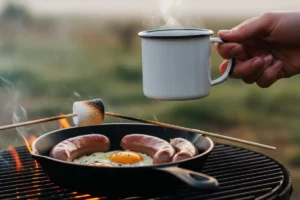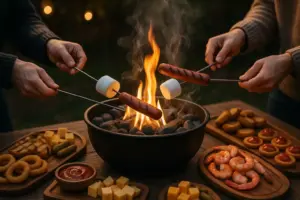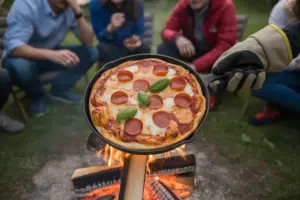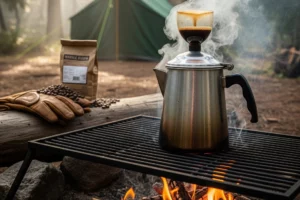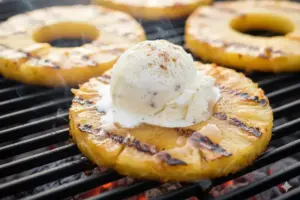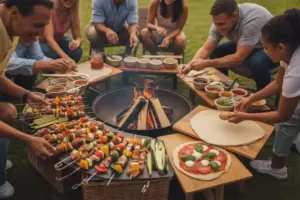How to Grill on a Camping Stove: A Beginner’s Guide to Perfect Campfire Meals
Picture this: you’re surrounded by towering pines, the crisp mountain air fills your lungs, and the gentle crackle of your camping stove signals the start of another outdoor adventure. But instead of settling for bland instant noodles or cold sandwiches, imagine savoring perfectly grilled chicken, seared vegetables, and smoky flavors that rival any backyard barbecue. Learning how to grill on a camping stove transforms ordinary camping trips into culinary adventures that satisfy both your hunger and your soul.
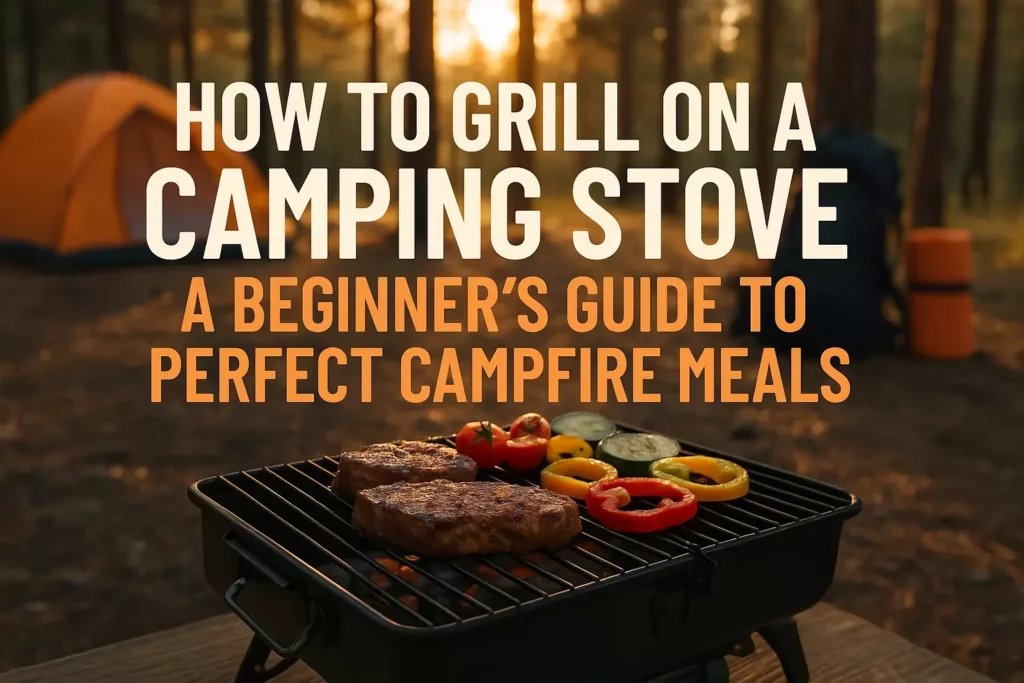
Whether you’re a weekend warrior or a seasoned outdoor enthusiast, mastering the art of grilling on a camping stove opens up endless possibilities for delicious meals in the wilderness. This comprehensive guide will walk you through everything you need to know to create restaurant-quality grilled food using nothing more than your trusty camping stove and a few essential techniques.
Key Takeaways
- Choose the right equipment: Select a stable camping stove with adjustable heat control and a compatible grill grate for optimal results
- Master heat management: Understanding temperature zones and proper preheating techniques is crucial for successful camping stove grilling
- Prepare ingredients properly: Pre-cut vegetables, marinate proteins, and organize your cooking station before lighting the stove
- Practice safety first: Always maintain proper ventilation, stable setup, and keep fire safety equipment nearby
- Start simple: Begin with easy-to-cook items like vegetables and thin cuts of meat before advancing to complex recipes
Understanding Camping Stove Grilling Basics
Grilling on a camping stove differs significantly from traditional backyard grilling, but the results can be equally impressive when done correctly. Unlike charcoal or gas grills, camping stoves provide precise heat control and quick setup, making them ideal for outdoor cooking adventures.
The key to successful camping stove grilling lies in understanding heat distribution and airflow. Most camping stoves create concentrated heat zones that require strategic food placement and regular rotation to achieve even cooking. The compact design of camping stoves actually offers advantages, including faster heating times, better fuel efficiency, and easier cleanup compared to larger grills.
Benefits of Camping Stove Grilling
Portability and convenience top the list of advantages when learning how to grill on a camping stove. These lightweight units pack easily into your camping gear without adding significant weight to your load. Additionally, camping stoves offer:
- Instant ignition without the need for charcoal preparation
- Precise temperature control for consistent cooking results
- Weather resistance that performs well in various outdoor conditions
- Minimal cleanup with fewer parts and surfaces to maintain
- Fuel efficiency that maximizes cooking time per fuel canister
Essential Equipment for Camping Stove Grilling
Success in camping stove grilling starts with selecting the right equipment. Your choice of stove, grill accessories, and cooking tools directly impacts your outdoor culinary experience.
Choosing the Right Camping Stove
Stability and heat output should guide your camping stove selection. Look for models with wide bases and adjustable legs that provide steady platforms on uneven terrain. The ideal camping stove for grilling produces at least 10,000 BTUs per burner and features precise flame control.
Popular camping stove types include:
Single-burner stoves: Perfect for solo campers or simple meals
Double-burner stoves: Ideal for groups and complex cooking
Integrated systems: Combine stove and cookware for streamlined packing
Wind-resistant models: Feature protective shields for challenging weather conditions
Must-Have Grilling Accessories
Transform your basic camping stove into a grilling powerhouse with these essential accessories:
| Accessory | Purpose | Key Features |
|---|---|---|
| Grill Grate | Creates grilling surface | Non-stick coating, proper sizing |
| Wind Screen | Protects flame | Adjustable height, heat reflection |
| Drip Pan | Catches grease | Easy cleanup, prevents flare-ups |
| Long-handled Tools | Safe food handling | Heat-resistant grips, compact storage |
Cooking Tools and Utensils
Quality tools make the difference between frustrating outdoor cooking and enjoyable meal preparation. Pack these essential items for successful camping stove grilling:
- Long-handled spatula for safe food flipping
- Tongs with good grip for precise food handling
- Instant-read thermometer for food safety
- Aluminum foil for wrapping and heat distribution
- Cutting board and sharp knife for meal preparation
- Heat-resistant gloves for handling hot equipment
Setting Up Your Camping Stove for Grilling
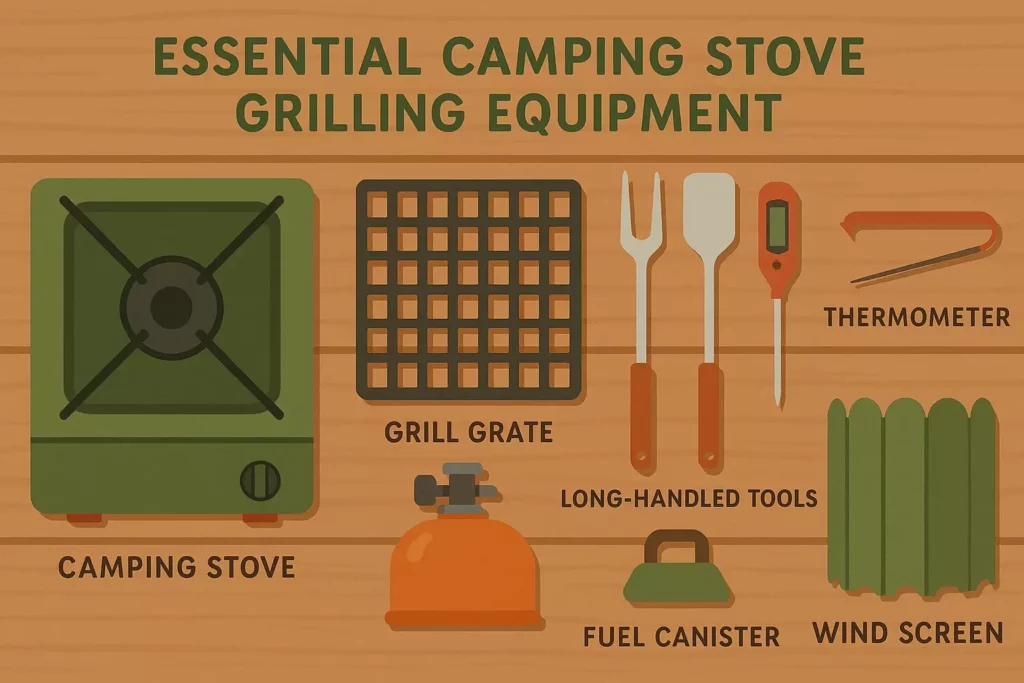
Proper setup forms the foundation of successful camping stove grilling. Location selection and equipment arrangement directly impact cooking performance and safety.
Choosing the Perfect Location
Scout your campsite for the ideal grilling spot before unpacking your equipment. Look for these characteristics:
Level ground ensures stable stove operation and prevents tipping. Use a small camping shovel to level the surface if necessary, or place the stove on a sturdy camping table.
Wind protection improves fuel efficiency and cooking control. Position your setup behind natural windbreaks like large rocks or trees, or create artificial barriers using camping gear.
Adequate ventilation prevents carbon monoxide buildup while maintaining airflow for proper combustion. Avoid enclosed spaces and ensure clear air circulation around your cooking area.
Safe distance from flammables protects your tent, gear, and surrounding vegetation. Maintain at least 10 feet from tents and dry grass, and keep a clear zone around your cooking area.
Assembling Your Grilling Station
Create an efficient workspace by organizing your equipment logically. Proper organization prevents accidents and streamlines the cooking process.
Start by setting up your camping stove on a stable surface, ensuring all connections are secure. Attach the grill grate and position wind screens if needed. Arrange your cooking tools within easy reach, and prepare a designated area for raw and cooked foods.
When setting up your campsite, consider the proximity of your cooking area to other camp activities. Position your grilling station downwind from sleeping areas to prevent smoke and cooking odors from disturbing rest.
Safety Considerations and Best Practices
Safety always comes first when learning how to grill on a camping stove. Outdoor cooking presents unique challenges that require constant awareness and preparation.
Fire Safety Essentials
Keep fire suppression materials readily available throughout your cooking session. Water, sand, or a fire extinguisher should be within arm’s reach of your grilling station. Never leave your camping stove unattended while in operation, even for brief moments.
Establish a clear evacuation plan and communicate it to all group members. Identify the nearest water source and ensure everyone knows how to quickly shut off the stove’s fuel supply in an emergency.
Fuel Handling and Storage
Proper fuel management prevents accidents and ensures consistent cooking performance. Store fuel canisters in cool, dry locations away from direct sunlight and heat sources. Check connections regularly for leaks using soapy water, and replace worn or damaged components immediately.
Always transport spare fuel canisters in approved containers and follow local regulations regarding fuel storage and disposal. Never attempt to refill disposable canisters, and properly dispose of empty containers according to manufacturer guidelines.
Food Safety in the Outdoors
Maintaining food safety standards becomes more challenging in outdoor environments. Temperature control and cleanliness require extra attention when camping.
Keep perishable foods in well-insulated coolers with adequate ice until ready to cook. Use separate cutting boards for raw meats and vegetables, and wash hands frequently with soap and clean water. When water sources are limited, consider water purification methods to ensure safe cleaning and cooking water.
Pack a comprehensive first aid kit that includes burn treatment supplies and basic medications for food-related illnesses.
Step-by-Step Grilling Techniques
Mastering fundamental grilling techniques transforms your camping stove into a versatile outdoor kitchen. Understanding heat management and timing ensures consistent results across different food types.
Preheating and Temperature Control
Proper preheating sets the stage for successful grilling. Light your camping stove and allow the grill grate to heat for 5-10 minutes before adding food. This process creates the high temperatures necessary for proper searing and prevents food from sticking.
Learn to recognize temperature zones on your grill surface. The center typically runs hottest, while edges provide moderate heat perfect for slower cooking. Use the hand test to gauge temperature: hold your hand 4 inches above the grate and count how long you can keep it there comfortably.
- 1-2 seconds: High heat (450°F+) – ideal for searing
- 3-4 seconds: Medium-high heat (400°F) – perfect for most proteins
- 5-6 seconds: Medium heat (350°F) – great for vegetables
- 7+ seconds: Low heat (300°F) – suitable for delicate items
Direct vs. Indirect Cooking Methods
Direct cooking places food directly over the heat source, creating high temperatures perfect for searing steaks, burgers, and vegetables. This method works best for foods that cook quickly and benefit from caramelization.
Indirect cooking uses reflected heat and works well for thicker cuts of meat that require longer cooking times. Create indirect zones by placing food away from the primary heat source or using aluminum foil to diffuse heat.
Food Preparation Techniques
Advance preparation streamlines the cooking process and ensures food safety. Pre-cut vegetables into uniform sizes for even cooking, and bring proteins to room temperature 15-20 minutes before grilling.
Marinating proteins adds flavor and helps tenderize tougher cuts. Pack pre-marinated meats in sealed containers or bags to prevent cross-contamination and reduce cleanup. When space is limited, consider dry rubs that provide flavor without additional liquid volume.
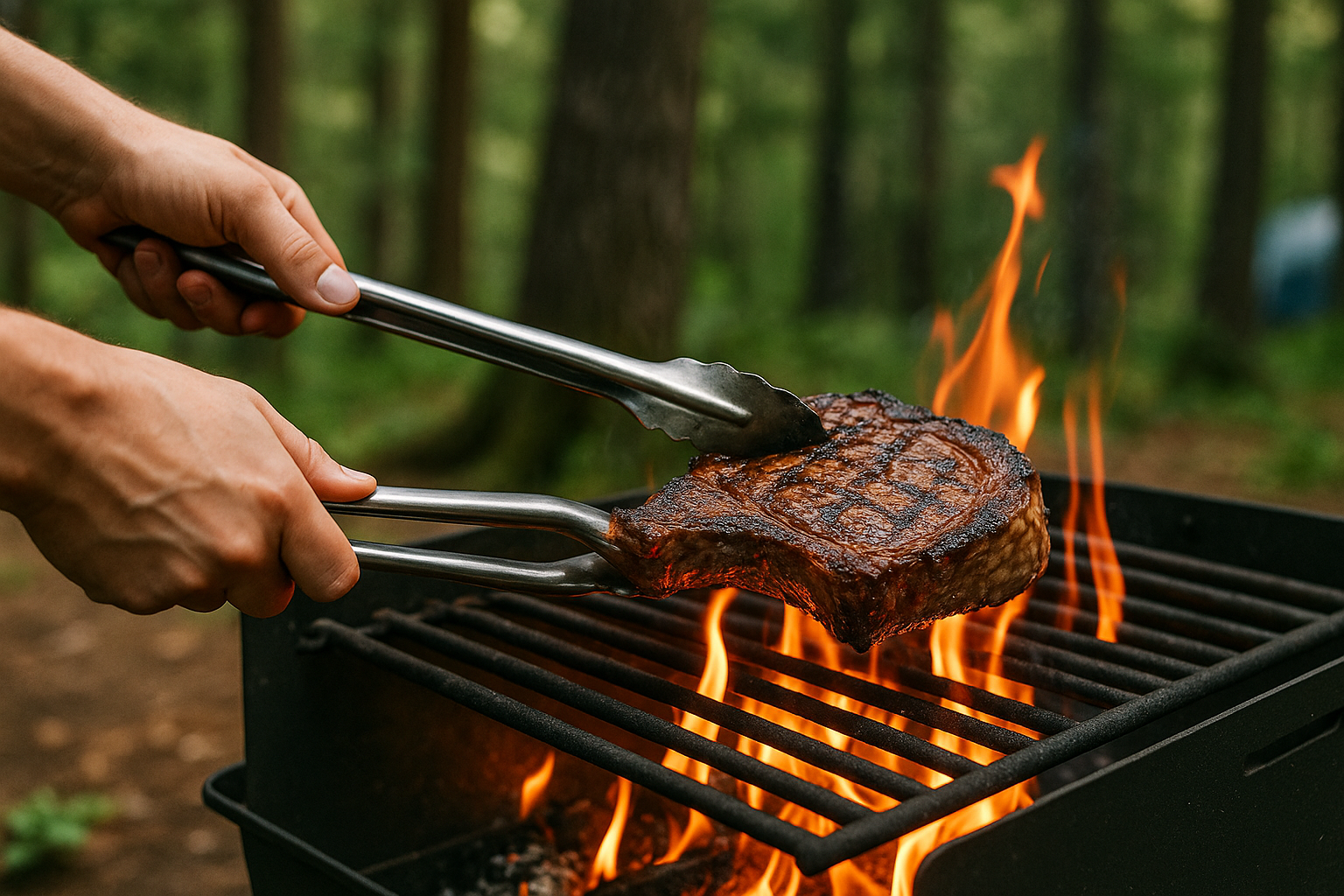🔥 Camping Stove Grilling Guide
Select a food type to see optimal temperature and cooking recommendations
Grilling Different Types of Food
Each food type requires specific techniques to achieve optimal results on a camping stove. Understanding these differences ensures consistently delicious meals regardless of what you’re cooking.
Proteins: Meat, Poultry, and Fish
Meat selection plays a crucial role in camping stove grilling success. Choose cuts that cook relatively quickly and evenly, such as steaks, chicken breasts, fish fillets, and ground meat patties.
For beef and pork, aim for cuts no thicker than 1.5 inches to ensure thorough cooking. Marinate tougher cuts beforehand to improve tenderness, and always allow meat to rest after cooking to redistribute juices.
Poultry requires careful attention to food safety and even cooking. Pound chicken breasts to uniform thickness, and consider pre-cooking partially thick pieces to reduce grilling time. Always verify internal temperatures reach 165°F for safe consumption.
Fish and seafood cook quickly and require gentle handling. Oil the grill grate generously to prevent sticking, and consider using aluminum foil for delicate fish varieties. Firm fish like salmon and tuna work best for direct grilling.
Vegetables and Sides
Vegetable preparation determines grilling success more than cooking technique. Cut vegetables into uniform sizes to ensure even cooking, and choose varieties that hold up well to high heat.
Excellent camping stove grilling vegetables include:
- Bell peppers and onions – slice into thick strips
- Zucchini and eggplant – cut into rounds or planks
- Corn on the cob – husk and wrap in foil
- Mushrooms – use large caps or skewer smaller varieties
- Asparagus – trim tough ends and bundle with string
Pre-cooking dense vegetables like potatoes and carrots partially before grilling reduces cooking time and ensures tender results. Steam or boil these vegetables until just tender, then finish on the grill for smoky flavor and appealing grill marks.
Creative Camping Recipes
Foil packet cooking expands your camping stove grilling repertoire significantly. Combine proteins, vegetables, and seasonings in heavy-duty aluminum foil for complete one-packet meals that cook evenly and require minimal cleanup.
Try these popular foil packet combinations:
- Chicken fajita packets with peppers, onions, and Mexican seasonings
- Salmon and vegetable packets with lemon, herbs, and olive oil
- Breakfast hash packets with potatoes, eggs, and breakfast meats
- Mediterranean packets with fish, tomatoes, olives, and herbs
Skewer cooking works exceptionally well on camping stoves and allows for creative ingredient combinations. Alternate proteins and vegetables on metal skewers for even cooking and attractive presentation.
Maintenance and Cleanup
Proper maintenance extends the life of your camping equipment and ensures consistent performance throughout your outdoor adventures.
Cleaning Your Equipment
Immediate cleanup prevents food residue from hardening and makes thorough cleaning easier. Allow the grill grate to cool slightly, then scrub with a stiff brush while still warm. Hot water and biodegradable soap remove grease effectively without harming the environment.
Deep cleaning should occur after every camping trip. Disassemble removable parts and wash thoroughly with hot, soapy water. Inspect all components for damage or wear, and address issues before your next outing.
Store equipment completely dry to prevent rust and corrosion. Apply a light coating of cooking oil to metal surfaces for additional protection during storage.
Storage and Transport
Organized packing protects your equipment and makes setup faster at your destination. Use padded cases or wrap fragile components in towels to prevent damage during transport.
When packing your camping gear, consider weight distribution and accessibility. Place frequently used items in easily accessible locations, and distribute weight evenly throughout your pack.
Fuel storage requires special attention to safety regulations and proper handling. Transport fuel canisters in approved containers, and check local regulations regarding fuel transport and disposal.
Troubleshooting Common Issues
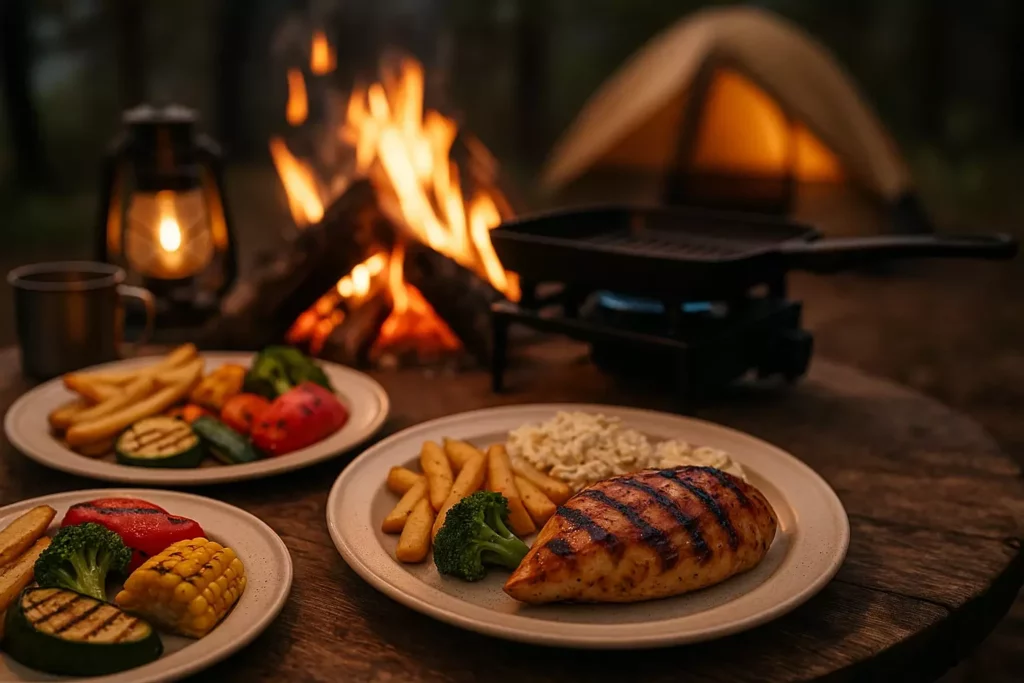
Problem-solving skills help you adapt to challenging conditions and equipment issues that may arise during outdoor cooking adventures.
Heat Control Problems
Inconsistent temperatures often result from wind interference or fuel supply issues. Install wind screens around your cooking area, and check fuel connections for leaks or blockages. Adjust flame settings gradually rather than making dramatic changes.
Hot spots on the grill surface require strategic food placement and regular rotation. Map your grill’s heat zones during preheating, and use these areas strategically for different cooking needs.
Weather-Related Challenges
Wind and rain present the biggest challenges for camping stove grilling. Create windbreaks using camping chairs, tarps, or natural features to protect your flame. In light rain, position a tarp overhead while maintaining adequate ventilation.
Cold weather affects fuel efficiency and ignition reliability. Keep fuel canisters warm before use, and allow extra time for preheating in cold conditions. Consider appropriate clothing to stay comfortable while cooking in challenging weather.
High altitude reduces air density and affects combustion efficiency. Expect longer cooking times and adjust flame settings accordingly. Fuel consumption may increase at higher elevations.
Advanced Tips and Techniques
Mastering advanced techniques elevates your camping stove grilling from basic outdoor cooking to gourmet wilderness dining experiences.
Temperature Zones and Heat Management
Creating temperature zones on a small camping stove requires creativity and strategic use of available space. Use aluminum foil to create heat deflectors that redirect heat flow and create cooler cooking areas.
Thermal mass techniques help maintain consistent temperatures for longer cooking times. Place clean rocks or cast iron near the heat source to absorb and radiate heat evenly. This technique works particularly well for slow-cooking applications.
Smoking and Flavoring Techniques
Wood chip smoking adds authentic barbecue flavors to camping stove grilling. Soak small wood chips in water for 30 minutes, then wrap in aluminum foil with holes poked throughout. Place the packet near the heat source to generate flavorful smoke.
Herb and spice crusts provide intense flavors without requiring additional equipment. Create dry rubs using available herbs and spices, and apply generously before cooking for maximum flavor impact.
Multi-Course Meal Planning
Strategic timing allows you to prepare complete meals using a single camping stove. Start with items requiring longest cooking times, and use residual heat for warming bread or melting chocolate for dessert.
Prep work organization streamlines the cooking process and prevents overcrowding your limited cooking space. Prepare ingredients in advance, and organize cooking tools for efficient workflow.
When camping with families, consider simple recipes that kids can help prepare, making mealtime a fun group activity rather than a chore.
Planning Your Camping Menu
Menu planning ensures you have appropriate ingredients and cooking times for successful camping stove grilling adventures.
Meal Prep and Ingredient Selection
Choose ingredients wisely based on storage requirements, cooking times, and nutritional needs. Opt for items that pack well, resist spoilage, and provide adequate nutrition for outdoor activities.
Pre-preparation at home saves time and reduces waste at the campsite. Marinate meats, chop vegetables, and pre-mix seasonings before leaving home. Pack ingredients in clearly labeled containers for easy identification.
Portion control prevents food waste and ensures adequate nutrition for all group members. Calculate serving sizes based on activity levels and group size, and pack slightly more than needed for safety.
Shopping and Packing Lists
Organized shopping ensures you don’t forget essential ingredients or overpack perishables. Create detailed lists organized by food category and storage requirements.
Essential camping stove grilling ingredients include:
- Proteins: Choose quick-cooking varieties
- Vegetables: Select sturdy options that travel well
- Seasonings: Pack versatile spices and marinades
- Oils and fats: Bring high-heat cooking oils
- Emergency foods: Include backup options for weather delays
Proper food storage maintains freshness and prevents contamination. Use insulated coolers with adequate ice, and pack raw meats separately from other ingredients. Monitor temperatures regularly, and consume perishables within safe timeframes.
Consider your overall camping meal planning strategy to ensure variety and nutritional balance throughout your trip.
Conclusion
Learning how to grill on a camping stove opens up a world of culinary possibilities that transform ordinary camping trips into memorable outdoor dining experiences. From selecting the right equipment and mastering heat control to preparing gourmet meals in the wilderness, these skills enhance every aspect of your outdoor adventures.
Success in camping stove grilling comes from understanding the fundamentals: proper equipment selection, safety practices, heat management, and food preparation techniques. Start with simple recipes and gradually build your skills as you gain confidence and experience with your equipment.
Remember that practice makes perfect when it comes to outdoor cooking. Each camping trip provides opportunities to refine your techniques, try new recipes, and discover what works best for your specific equipment and cooking style. Don’t be discouraged by initial challenges – even experienced outdoor cooks encounter setbacks and learning opportunities.
Safety always remains the top priority in all outdoor cooking activities. Maintain proper equipment, follow safety protocols, and be prepared for changing conditions that may require adaptations to your cooking plans.
Your next camping adventure awaits, and with these skills in your outdoor toolkit, you’re ready to create delicious, memorable meals that rival any restaurant experience. Pack your gear, plan your menu, and prepare to discover the joy of grilling on a camping stove in the great outdoors.

